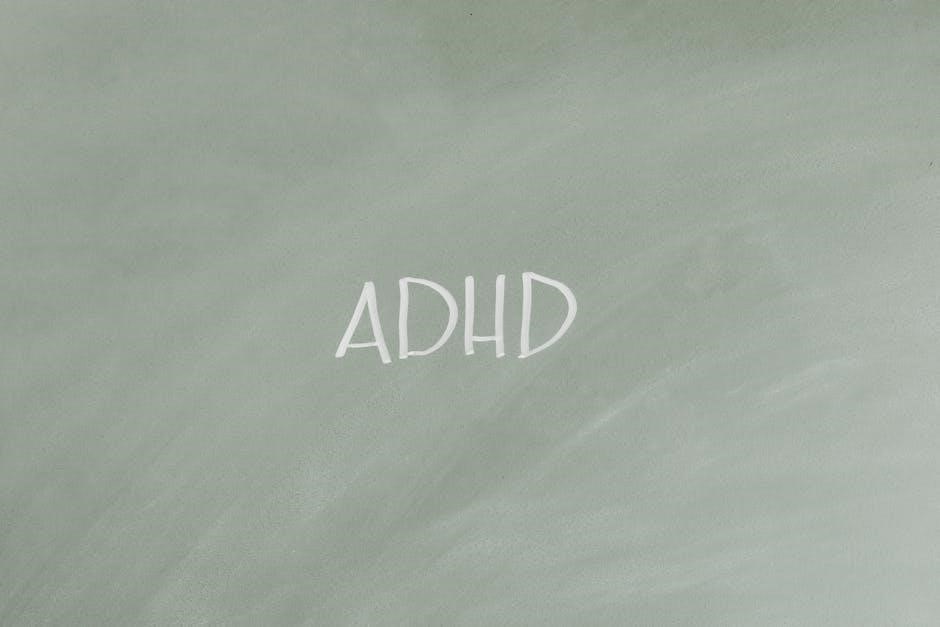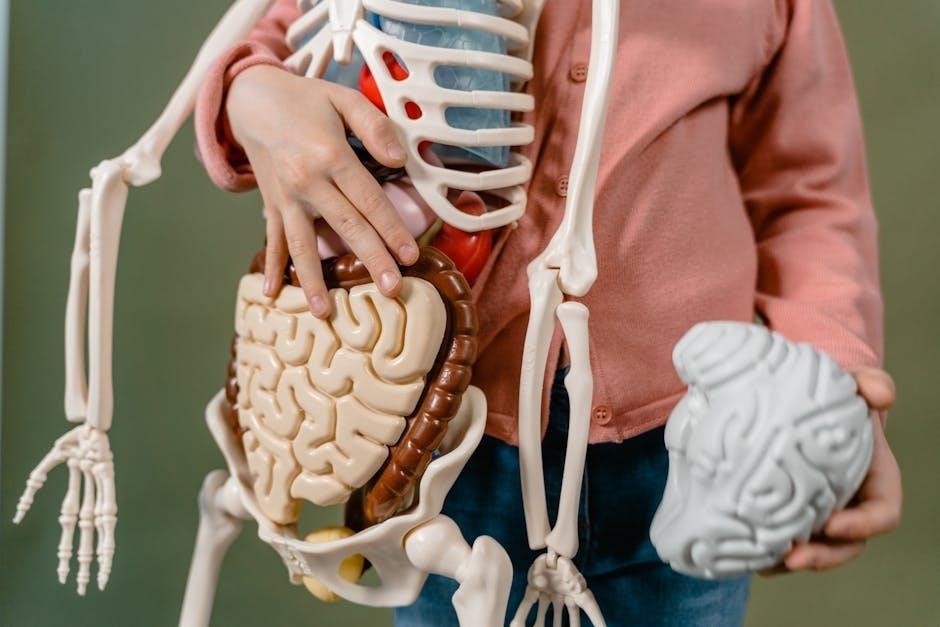This groundbreaking book by Norman Doidge explores neuroplasticity, revealing how the brain can rewire and adapt throughout life, challenging the idea of a fixed brain structure.
1;1 Overview of the Book
The Brain That Changes Itself by Norman Doidge is a transformative exploration of neuroplasticity, the brain’s extraordinary ability to rewire and adapt throughout life. Through compelling case studies, Doidge presents stories of individuals who overcame previously deemed incurable conditions, such as stroke, cerebral palsy, and depression, by harnessing the brain’s plasticity. The book challenges the long-held belief that the brain is fixed after adulthood, offering hope and insights into the potential for healing and growth. Doidge, a psychiatrist and psychoanalyst, weaves together cutting-edge science and personal narratives, making the concept of neuroplasticity accessible and inspiring for both scientists and general readers. This groundbreaking work has reshaped our understanding of the brain’s capacity for change and recovery.
1.2 Author Norman Doidge and His Work
Norman Doidge, a psychiatrist, psychoanalyst, and researcher, is renowned for his groundbreaking work on neuroplasticity. His book, The Brain That Changes Itself, has sold over a million copies worldwide, earning praise from luminaries like Oliver Sacks and VS Ramachandran. Doidge’s work challenges the notion of a fixed brain, showcasing its remarkable adaptability through real-life case studies. He has also authored The Brain’s Way of Healing, further exploring neuroplasticity’s potential. Doidge’s writing bridges science and storytelling, making complex concepts accessible. His work has significantly influenced neuroscience, medicine, and public understanding of brain function, solidifying his role as a leading voice in the field of neuroplasticity and brain science.
1.3 Key Themes and Concepts
The book introduces neuroplasticity as its central theme, highlighting the brain’s ability to rewire and adapt throughout life. It challenges the long-held belief that the brain is fixed after adulthood, offering compelling evidence of its malleability. Key concepts include synaptic plasticity, where connections between neurons strengthen or weaken based on experience, and neural rewiring, where damaged areas can be taken over by healthy ones. The book also explores the role of thought and experience in reshaping brain structure and function, emphasizing the potential for recovery and growth even in cases of severe injury or chronic conditions. These ideas are supported by real-life case studies, making the concepts relatable and accessible to readers.

Understanding Neuroplasticity
Neuroplasticity refers to the brain’s remarkable ability to change, adapt, and reorganize itself by forming new neural connections, which challenges the notion of a fixed brain structure.
2.1 Definition and Explanation of Neuroplasticity
Neuroplasticity, or brain plasticity, refers to the brain’s extraordinary ability to change, adapt, and reorganize itself by forming new neural connections throughout life. This concept challenges the long-held belief that the brain is a fixed, unchangeable entity. Neuroplasticity occurs at various levels, from microscopic changes in individual neurons to larger-scale remapping of brain areas. It is driven by experiences, learning, environmental factors, and even thoughts. This dynamic process allows the brain to recover from injuries, adapt to new situations, and compensate for damaged areas. Neuroplasticity is not limited to early life; it continues into adulthood, offering hope for recovery and improvement in both physical and mental health. Understanding this phenomenon has revolutionized neuroscience and opened new possibilities for treatment and personal growth.
2.2 Types of Neuroplasticity
Neuroplasticity is categorized into several types, each representing distinct mechanisms of brain adaptation. Synaptic plasticity involves strengthening or weakening connections between neurons, often linked to learning and memory. Structural plasticity refers to the physical reorganization of brain tissue, such as the growth of new neurons or the formation of new neural pathways. Functional plasticity describes changes in how brain areas communicate and process information. Neurogenesis, the birth of new neurons, is another form, primarily occurring in the hippocampus; These types of plasticity are not mutually exclusive and often work together, enabling the brain to adapt to injuries, environmental changes, and psychological experiences. Understanding these categories provides insights into how neuroplasticity contributes to recovery, learning, and overall brain resilience.
2.3 Historical Development of the Concept
The concept of neuroplasticity emerged from centuries of scientific inquiry, challenging the long-held belief that the brain is a fixed, unchangeable entity. Early ideas about brain adaptability were met with skepticism until modern research provided evidence of its existence. The term “neuroplasticity” was popularized in the late 20th century, with Norman Doidge’s work playing a pivotal role in bringing it to the forefront. Historical milestones include the discovery of synaptic plasticity and the groundbreaking work of scientists like Santiago Ramón y Cajal, who laid the foundation for understanding neural regeneration. These developments have revolutionized neuroscience, offering hope for treating injuries and disorders once deemed irreversible.

Case Studies and Real-Life Applications
The book showcases remarkable recoveries, such as a woman without a cerebellum learning to walk, highlighting neuroplasticity’s power in overcoming brain injuries and mental health challenges.
3.1 Notable Case Studies from the Book
The book features extraordinary case studies, such as a woman born without a cerebellum who learned to walk and a blind man who “sees” through sound. These stories demonstrate neuroplasticity’s potential to overcome severe brain injuries and disabilities. Doidge shares accounts of individuals with strokes, autism, and other conditions who achieved remarkable recoveries through targeted therapies. One notable case is a man who regained language abilities after years of aphasia. These real-life examples highlight neuroplasticity’s power to rewire the brain, offering hope for those with previously deemed incurable conditions. The cases are deeply personal and scientifically compelling, illustrating the brain’s extraordinary adaptability.

3.2 Neuroplasticity in Recovery from Brain Injuries
Neuroplasticity plays a pivotal role in recovery from brain injuries by enabling the brain to reorganize itself. After strokes or traumatic injuries, undamaged areas can take over functions lost by damaged regions. Techniques like cognitive training and rehabilitation exercises leverage this adaptability, helping patients regain motor skills, language, and memory. For instance, individuals with aphasia have shown significant improvement through intensive speech therapy. Neuroplasticity-based approaches tailor treatments to harness the brain’s compensatory mechanisms, offering personalized recovery paths. While outcomes vary, these methods demonstrate the brain’s remarkable capacity to adapt and recover, providing hope for those affected by brain injuries. This concept revolutionizes rehabilitation, emphasizing the brain’s lifelong potential for change and adaptation.
3.3 Applications in Mental Health and Wellness
Neuroplasticity has revolutionized mental health treatment, offering innovative approaches for conditions like depression, anxiety, and PTSD. Techniques such as cognitive-behavioral therapy (CBT) and mindfulness practices leverage the brain’s adaptability to rewire negative thought patterns. These methods help patients develop healthier neural pathways, enhancing emotional resilience and well-being. By focusing on neuroplasticity, mental health professionals can tailor treatments to individual needs, promoting long-term recovery and stability. This approach emphasizes the brain’s lifelong capacity for change, providing hope and effective solutions for various mental health challenges.

The Science Behind Neuroplasticity
Neuroplasticity involves neural rewiring and synaptic changes, allowing the brain to adapt and reorganize itself by forming new neural connections throughout life, enhancing functionality and recovery.
4.1 Neural Rewiring and Synaptic Plasticity
Neural rewiring and synaptic plasticity are core mechanisms of neuroplasticity, enabling the brain to reorganize itself by forming new neural connections. Synaptic plasticity refers to the strengthening or weakening of connections between neurons, allowing the brain to adapt and learn. This process is fundamental to recovery from brain injuries and learning new skills. Neural rewiring involves the creation of new pathways, compensating for damaged areas. These mechanisms demonstrate the brain’s remarkable ability to restructure itself, challenging the long-held belief that the brain is immutable. This adaptability is central to the concept of neuroplasticity, offering hope for rehabilitation and cognitive improvement.
4.2 The Role of Neurons and Neural Pathways
Neurons and neural pathways are the foundational elements of brain function, enabling communication and adaptation. Neurons, or nerve cells, transmit signals through electrical and chemical processes, forming complex networks. Neural pathways, the connections between neurons, are essential for learning, memory, and behavior. Neuroplasticity allows these pathways to reorganize, strengthening some connections while weakening others. This adaptability enables the brain to compensate for injuries and learn new skills. The dynamic interaction between neurons and pathways underscores the brain’s remarkable capacity for change, highlighting the central role of neuroplasticity in brain function and recovery. This mechanism is vital for understanding how the brain evolves and adapts throughout life.
4.3 Modern Research and Discoveries
Modern research has significantly advanced our understanding of neuroplasticity, revealing its vast potential for brain recovery and adaptation. Recent studies highlight the role of neuroimaging and AI in mapping neural changes, enabling precise tracking of plasticity. Discoveries in synaptic plasticity and neuronal regeneration have opened new avenues for treating neurological disorders. Emerging therapies, such as transcranial magnetic stimulation (TMS) and brain-computer interfaces, leverage neuroplasticity to restore function; These advancements demonstrate that the brain’s ability to rewire itself is not only lifelong but also highly dynamic, offering hope for diverse applications in medicine and beyond. Ongoing research continues to uncover the brain’s remarkable adaptability, revolutionizing neuroscience and therapy development.

The Impact of “The Brain That Changes Itself”
The book revolutionized neuroscience by popularizing neuroplasticity, inspiring new treatments for brain injuries and mental health, and transforming societal views on brain adaptability and human potential.
5.1 Popularity and Reception of the Book
The Brain That Changes Itself has achieved remarkable popularity worldwide, selling over a million copies and earning widespread acclaim. Renowned neuroscientists like Oliver Sacks and V.S. Ramachandran praised its insights. The book has been translated into multiple languages and remains a bestseller in neuroscience and self-help categories. Its engaging storytelling and accessible explanation of neuroplasticity made it a favorite among both professionals and the general public. The book’s success lies in its ability to bridge complex scientific concepts with real-life stories, inspiring hope for those with brain injuries or mental health challenges. Its influence extends beyond academia, shaping public understanding of brain adaptability and personal transformation.
5.2 Influence on Neuroscience and Medicine
The Brain That Changes Itself has profoundly impacted neuroscience and medicine by popularizing neuroplasticity. It challenged the long-held belief that the brain is immutable, offering new hope for recovery from injuries and mental health disorders. The book influenced medical practices, inspiring therapies based on neuroplastic principles, such as cognitive rehabilitation and neurofeedback. Researchers have adopted its concepts to develop innovative treatments for stroke, autism, and ADHD. By bridging science and accessible storytelling, Doidge’s work has accelerated advancements in brain science, making neuroplasticity a cornerstone of modern medical approaches. Its influence continues to shape research and clinical applications, revolutionizing the field’s understanding of brain adaptability and recovery potential.
5.3 Cultural and Societal Implications
The Brain That Changes Itself has sparked a cultural shift by empowering individuals to embrace brain adaptability. It challenges societal views on aging, disability, and mental health, fostering hope and resilience. Neuroplasticity’s concept has inspired educational reforms, emphasizing lifelong learning and brain health. It has also influenced workplace practices, promoting mental well-being and adaptability. The book’s impact extends to parenting, encouraging nurturing environments for brain development. By making neuroplasticity mainstream, it has reduced stigma around brain injuries and disorders, advocating for a more compassionate society. Its influence is evident in the rise of brain training programs and therapies, reflecting a broader societal commitment to harnessing the brain’s potential for overall well-being and personal growth.

Future of Neuroplasticity and Its Potential
Emerging research and advancements in neuroplasticity promise groundbreaking therapies, enhanced cognitive abilities, and innovative treatments, reshaping medicine and human potential.
6.1 Emerging Research and Trends
Emerging research in neuroplasticity highlights groundbreaking discoveries in synaptic plasticity, neurogenesis, and neural adaptation. Advances in brain imaging and AI-driven analytics enable deeper insights into how neurons rewire. Studies focus on enhancing cognitive recovery post-injury, improving mental health treatments, and delaying neurodegenerative diseases. Non-invasive stimulation techniques like TMS and tDCS show promise in boosting plasticity. Additionally, epigenetic research explores how environmental factors shape brain adaptability. These trends underscore neuroplasticity’s vast potential, offering hope for transformative therapies and personalized brain health solutions. The integration of technology, such as neuroprosthetics and brain-computer interfaces, further accelerates the field, paving the way for unprecedented advancements in human cognition and recovery.
6.2 Potential Breakthroughs and Applications
Potential breakthroughs in neuroplasticity could revolutionize treatments for stroke, Alzheimer’s, and PTSD. Applications include personalized neurotherapy, enhancing learning, and improving mental health. Emerging technologies like brain-computer interfaces may restore function in paralyzed individuals. Advances in neuroplasticity-based rehabilitation could offer new hope for recovery, while educational tools leveraging plasticity principles might improve learning outcomes. These innovations could transform healthcare and education, offering tailored solutions for cognitive and neurological challenges. The future holds immense promise for harnessing neuroplasticity to enhance human potential and quality of life, making it a cornerstone of modern medicine and personal development.
6.3 The Role of Technology in Advancing Neuroplasticity
Technology plays a pivotal role in advancing neuroplasticity, offering innovative tools to enhance brain adaptability. Emerging technologies like brain-computer interfaces and neurofeedback devices enable precise monitoring and manipulation of neural activity. Non-invasive brain stimulation techniques, such as transcranial magnetic stimulation (TMS) and transcranial direct current stimulation (tDCS), are being refined to promote neuroplasticity. Additionally, neuroprosthetics and AI-driven rehabilitation systems are revolutionizing recovery for individuals with brain injuries. These advancements not only improve understanding of neuroplasticity but also provide practical applications, making it possible to harness the brain’s adaptability for therapeutic and cognitive enhancement. Technology continues to unlock new possibilities, bridging the gap between scientific discovery and real-world applications.
